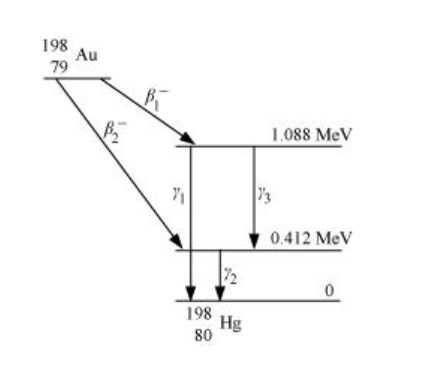Obtain the maximum kinetic energy of β-particles, and the radiation frequencies of γ decays in the decay scheme shown in Fig. 13.6. You are given that
m (198Au) = 197.968233 u
m (198Hg) =197.966760 u

It can be observed from the given γ-decay diagram that γ1 decays from the 1.088 MeV energy level to the 0 MeV energy level.
Hence, the energy corresponding to γ1-decay is given as:
E1 = 1.088 − 0 = 1.088 MeV
hν1= 1.088 × 1.6 × 10−19 × 106 J
Where,
h = Planck’s constant = 6.6 × 10−34 Js
ν1 = Frequency of radiation radiated by γ1-decay
$\therefore v_{1}=\frac{E_{1}}{h}$
$=\frac{1.088 \times 1.6 \times 10^{-19} \times 10^{6}}{6.6 \times 10^{-34}}=2.637 \times 10^{20} \mathrm{~Hz}$
It can be observed from the given γ-decay diagram that γ2 decays from the 0.412 MeV energy level to the 0 MeV energy level.
Hence, the energy corresponding to γ2-decay is given as:
E2 = 0.412 − 0 = 0.412 MeV
hν2= 0.412 × 1.6 × 10−19 × 106 J
Where,
ν2 = Frequency of radiation radiated by γ2-decay
$\therefore v_{2}=\frac{E_{2}}{h}$
$=\frac{0.412 \times 1.6 \times 10^{-19} \times 10^{6}}{6.6 \times 10^{-34}}=9.988 \times 10^{19} \mathrm{~Hz}$
It can be observed from the given γ-decay diagram that γ3 decays from the 1.088 MeV energy level to the 0.412 MeV energy level.
Hence, the energy corresponding to γ3-decay is given as:
E3 = 1.088 − 0.412 = 0.676 MeV
hν3= 0.676 × 10−19 × 106 J
Where,
ν3 = Frequency of radiation radiated by γ3-decay
$\therefore v_{3}=\frac{E_{3}}{h}$
$=\frac{0.676 \times 1.6 \times 10^{-19} \times 10^{6}}{6.6 \times 10^{-34}}=1.639 \times 10^{20} \mathrm{~Hz}$
Mass of $m\left({ }_{78}^{198} \mathrm{Au}\right)=197.968233 \mathrm{u}$
Mass of $m\left({ }_{80}^{198} \mathrm{Hg}\right)=197.966760 \mathrm{u}$
1 u = 931.5 MeV/c2
Energy of the highest level is given as:
$E=\left[m\left({ }_{78}^{198} \mathrm{Au}\right)-m\left({ }_{80}^{190} \mathrm{Hg}\right)\right]$
$=197.968233-197.966760=0.001473 \mathrm{u}$
$=0.001473 \times 931.5=1.3720995 \mathrm{MeV}$
β1 decays from the 1.3720995 MeV level to the 1.088 MeV level
∴Maximum kinetic energy of the β1 particle = 1.3720995 − 1.088
= 0.2840995 MeV
β2 decays from the 1.3720995 MeV level to the 0.412 MeV level
∴Maximum kinetic energy of the β2 particle = 1.3720995 − 0.412
= 0.9600995 MeV
Click here to get exam-ready with eSaral
For making your preparation journey smoother of JEE, NEET and Class 8 to 10, grab our app now.
